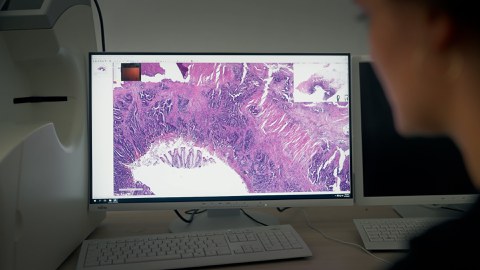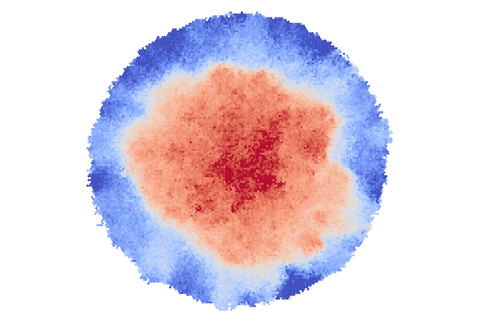Aug 22, 2024
How cancer adapts and changes: Study develops innovative model approach for describing the unique properties of cancer cells

Stained tissue section of part of the stomach wall. The purple-dark areas show a tumor in the gastric mucosa that is growing into the depths of the tissue.
An international research team led by scientists from the Center for Interdisciplinary Digital Sciences (CIDS) at TU Dresden has published a study on the complex evolutionary processes in tumors.
Cancer is one of the leading causes of death worldwide. Tumors consist of cells that differ in terms of genetics and their behavior. This so-called tumor heterogeneity makes it extremely difficult to cure cancer, as it enables resistance to therapy: The more diverse the tumor cells, the more likely it is that some will be resistant and survive treatment.
An international research team led by scientists from the Center for Interdisciplinary Digital Sciences (CIDS) at TUD Dresden University of Technology has made significant progress in understanding tumor heterogeneity and its impact on cancer treatment. The results of the study have now been published. The study was conducted in collaboration with researchers from Norway, the United Kingdom and the United Arab Emirates. It sheds light on the complex interrelation between irreversible genetic changes and reversible behavioral changes of tumor cells. The latter enable tumor cells to adapt their properties to their environment in a reversible manner. Specialists often speak of phenotypic plasticity. The researchers were able to demonstrate that the adaptability of tumor cells contributes significantly to the heterogeneity within tumors.
The international research team has developed an innovative model approach to describe the individual genetic and non-genetic properties of cancer cells. The study reveals that cells at the edge of the tumor develop in favor of faster migration and cells inside the tumor develop in favor of faster growth. The results also show that tumors with high phenotypic plasticity have a significantly lower chance of therapeutic success. These findings offer a new explanation for heterogeneous patterns in patients with glioblastoma, a particularly malignant brain tumor. The results of the study could have a significant impact on future therapeutic approaches.

Development of tumor heterogeneity. Simulation example. Natural selection results in a heterogeneous tumor with a dense tumor core of fast-growing cells (red) surrounded by a diffuse tumor border of invasive cells (blue).
"The study is another result of our years of research into modeling dynamic biological processes in cells, tissues and organs. Our mathematical model offers new possibilities for deciphering the cellular diversity in tumors and for developing new approaches in diagnostics, prevention and therapy," emphasizes Prof. Andreas Deutsch, Head of the ZIH Unit Innovative Methods of Computing.
"Evolution of phenotypic plasticity leads to tumor heterogeneity with implications for therapy" in the PLOS Computational Biology journal: https://journals.plos.org/ploscompbiol/article?id=10.1371/journal.pcbi.1012003
